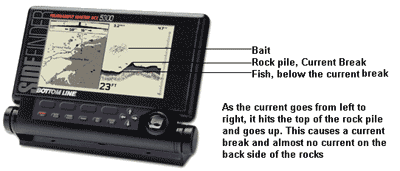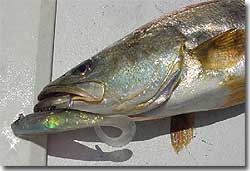Deep Water Trout in the Heat of the Summer
Deep Water Trout in the Heat of the Summer
By Jim Hammond
Think about this. Most of us have our best catches of trout in the cooler months. Why is this? Because as a rule tout like water to be cooler than it is during the hotter summer months. When most of the water is in the mid to high 80's, these fish are looking for a place where the water temperature is cooler, in the low 80's to high 70 degree mark. When the water is hot in most of our usual spots, what do we do to find these trout that are gathered up in the cooler water? We look for places that have clean cool water? This is almost always places where the water is deeper than 14 feet. Cooler water is going to be in the deeper parts of the river and creeks as cooler water is heavier than hotter water thus the cooler water sinks. This is what I do to find these spots. I start by looking. Now looking is different than fishing. When I am looking, I do not hesitate in driving my boat over a spot that I might want to fish later. I would NEVER drive over a spot if I was going to fish it right then. As a rule you will run the fish off of this spot if you drive over it. It is okay to do this when you are looking for a spot to come back to later but not if you are wanting to fish it now. I turn on my Bottom Line recorder with the zoom function turned on and I ease over the spot that I think might hold fish. What are these spots that I think might hold fish and what makes them any different than any other spot in the river or ICW. Two of the most important things to look for are current breaks and structure, which usually cause current breaks. These fish are no different than you and I as far as the amount of energy that they want to use in search of a meal. If they can get behind a rock pile that causes the current to slow down on the back side of the rocks then they are sure likely to use this CURRENT BREAK to their advantage. As the water passes over a rock pile or around a dock piling the structure causes an eddy on the down current side of these pieces of structure and these pieces of structure also create an ambush point that the fish can use to dart out from as bait passes by. With your recorder turned on to the zoom function, you can see very small rocks and if you really look close, you can see current if it is strong enough. I like to look for bait in and around the structure on the bottom and around the docks that I like to fish. The bait is going to show up as little dots or fuzz on your recorder.  This principle works the same way with dock piles, dolphins (the things that ships tie up to) or where two or more creeks come together. This principle works the same way with dock piles, dolphins (the things that ships tie up to) or where two or more creeks come together. TIDE:
Here's a monkey wrench that I want to throw in. Tide plays a big factor in this equation, as the bait or fish might not be there on a different tide. Just because they were the on the incoming does not mean they will be there on the outgoing. Looking for these spots is going to be a process that will take some time but after you have found several places that are holding these nice trout, the work that you put into this will be all worth it. You are going to have to have several places like this, because the fish might not always be on the spot that they were last time. I have spent many hours with my recorder on, going slow, looking for these places. I usually keep a note pad so I can take notes as to the location of the place, what the tide was doing, what time it was (this I will use when I get home to see exactly where I was on the tide when I saw these fish), which direction the wind was blowing (this can affect the direction of the current) and what exactly did I see down there. These notes will surely help you to be able to come back to the spot on a later date. If you have a GPS, you can save it as a waypoint. You will not believe how difficult it is to find a small spot in the middle of open water when you are trying to line up several points.  Here is a photo of a nice trout with the soft plastic mullet bait in it's mouth. Here is a photo of a nice trout with the soft plastic mullet bait in it's mouth. This past week I was able to use some of these techniques to land several nice trout from a deep spot that held bait and fish. I threw a diving MirrOlure, an inline spinner and a jig head with a soft plastic mullet imitation. Working these baits, I used a 7 foot long graphite rod that was spooled with 10 pound test Power Pro. The reason for such specifics is you will need a sensitive rod to feel the structure. You want to be able to be in contact with the bottom or just off of the bottom and you need the sensitivity of this type of outfit to do this
|
